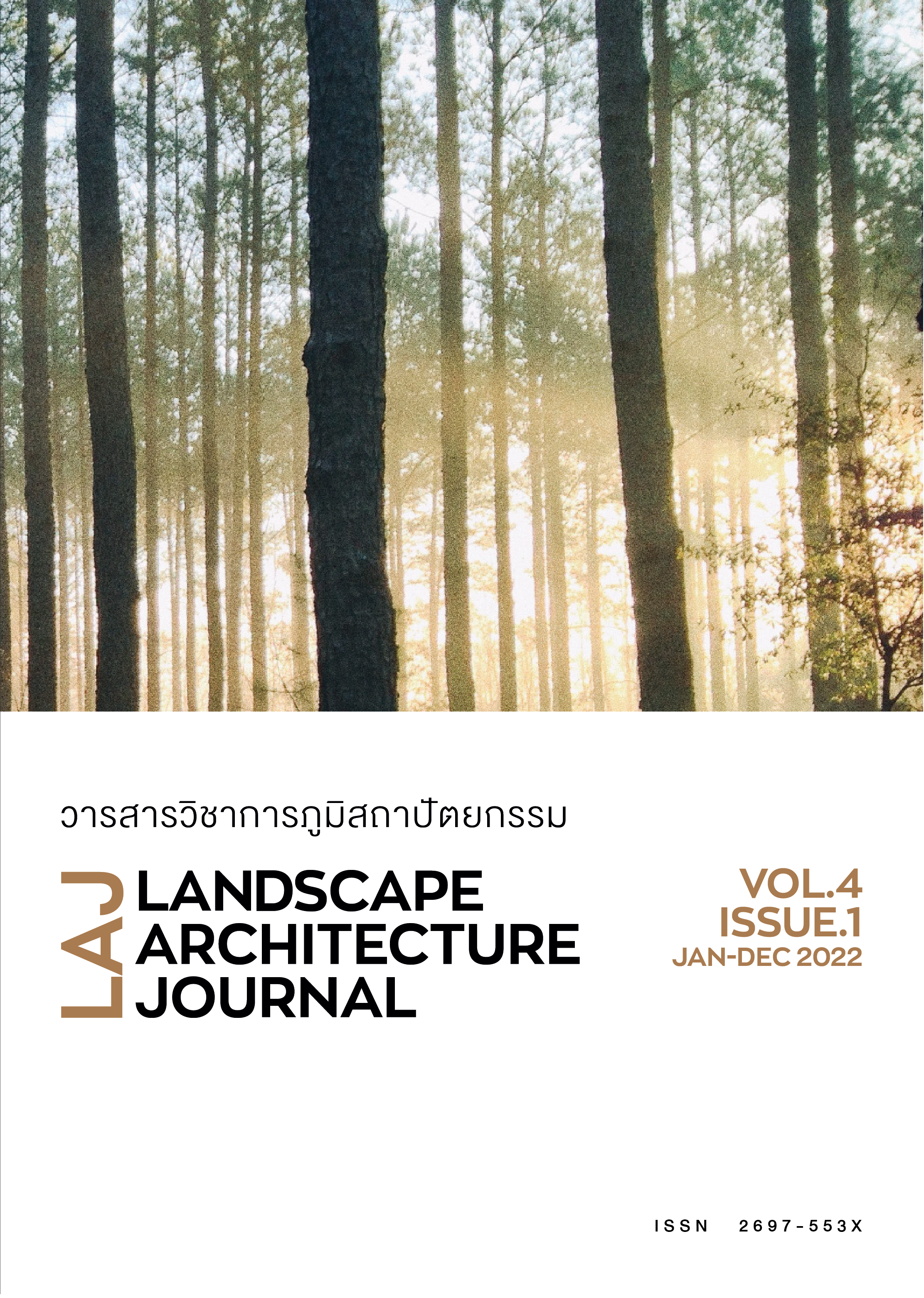Key Takeaways from Urban Forests: Forest Urbanism & Global Warming Conference 2022 and the Application to Bangkok’s One Million Trees Project
Main Article Content
Abstract
One Million Trees project is a method for environmental impact mitigation and carbon reduction for cities. It started from the One Million Trees Project in Los Angeles in 2006 and became One Million Trees Movement as a mission to fight climate change in many cities around the world. Bangkok, Thailand has also adopted the One Million Trees project. Bangkok plans to plant more trees equally in every district of the city starting in 2022. Although tree planting and creating urban forests are important tools for a Nature-based solution and a pivotal method for climate crisis, it is important to recognize urban tree planting requires considerable planning in addition to multitude other factors. Planting large numbers of new trees or high density of trees in a short period of time may not be the solution for urban environmental issues. Planting more trees without the proper planning and not having a proper understanding of planting sites can both adversely affect the urban ecology as well as the wellbeing of the city in short term and long term. The lack of an appropriate maintenance plan and an insufficient maintenance budget can also affect the health of the trees which could be a potential liability in public spaces. This paper is an accumulation, analysis, and summary of what was taken away from the Conference on Urban Forests: Forest Urbanism & Global Warming (UFFU Conference 2022) in June 2022 in Belgium by analyzing and summarizing key messages from the talks, presentations, discussions, and sharing with researchers, designers, foresters, botanists, and experts from the field. It also proposes primary methods that could be beneficial for Bangkok’s One Million Tree project and Urban Forest Plan.
Article Details

This work is licensed under a Creative Commons Attribution-NonCommercial-NoDerivatives 4.0 International License.
References
กนกวลี สุธีธร. (2565). คุณค่าทางนิเวศของต้นไม้ในเมืองกับงบประมาณการจัดการพื้นที่สีเขียวใน 50 เขตของกรุงเทพมหานคร. กรุงเทพฯ : จุฬาลงกรณ์มหาวิทยาลัย.
“ชัชชาติ” ดีใจคนแห่จองปลูกต้นไม้ทะลุ 1.3 ล้านต้นจ่อขยับเป้า 2 ล้าน. (3 กรกฎาคม 2565). บ้านเมือง. สืบค้นจาก https://www.banmuang.co.th/news/politic/286629
ทีมข่าวสิ่งแวดล้อม. (17 พฤษภาคม 2560). เผยสถิติ ‘ต้นไม้’ เมืองกรุงเฉียด 3.2 ล้านต้น ส่วนใหญ่เสี่ยงโค่น เหตุไร้รากแก้ว-ดินอุ้มน้ำ -รองผู้ว่าฯ กทม. ระบุ ไม้ยืนต้นกว่า 3.2 ล้านต้นในเมืองกรุงส่วนใหญ่ไม่มีรากแก้ว เหตุปลูกหลังสร้างถนน-บ้านเรือน. GREEN NEWS. สืบค้นจาก https://greennews.agency/?p=13986
Chadchart.com. (2022). ปลูกต้นไม้ล้านต้น สร้างพื้นที่สีเขียวและกำแพงกรองฝุ่นทั่วกรุง. สืบค้นจาก https://www. chadchart.com/policy/6215eef94e43cd8b4760bc16
City of Boston. (2022). Urban forest plan- we’re planning for the protection and expansion of Boston’s urban forest. Retrieved from https://www.boston.gov/departments/parks-and-recreation/urban-forest-plan
City of Melbourne. (2022). Highest and Best Use (HABU) Timber Program. Retrieved from https://www. melbourne.vic.gov.au/community/greening-the-city/tree-protection-management/Pages/habu-timber-program.aspx
Garrison, J. D. (2017). Seeing the park for the trees: New York’s “million trees” campaign vs. the deep roots of environmental inequality. Environment and Planning B: Urban Analytics and City Science, 46(5). DOI: 10.1177/2399808317737071
Jim, C. Y., Konijnendijk van den Bosch, C., & Chen, W. Y. (2018). Acute Challenges and Solutions for Urban Forestry in Compact and Densifying Cities. Journal of Urban Planning and Development, 144(3), DOI: 04018025 0-12
King County. (2021). 3 Million Trees by 2025. Plant. Protect. Prepare. Retrieved from: https://kingcounty. gov/services/environment/stewardship/three-million-trees.aspx
Landi, B. (2021, June 8). South Korea to plant 3 billion trees by 2050. INHABITAT. Retrieved from https://inhabitat.com/south-korea-to-plant-3-billion-trees-by-2050/
McBride, J. R., & Laćan, I. (2018). The impact of climate-change induced temperature increases on the suitability of street tree species in California (USA) cities. Urban Forestry & Urban Greening, 34, 348–356. DOI: 10.1016/j.ufug.2018.07.020
McPherson, G. E., Simpson, J. R., Xiao, Q., & Wu, C. (2011). Million trees Los Angeles canopy cover and benefit assessment. Landscape and Urban Planning, 99(1), 40–50. DOI: 10.1016/j.landurbplan. 2010.08.011
Miller, R. W. (2007). Urban Forestry: Planning and Managing Urban Greenspaces. Illinois: Waveland Press.
Paquette, A., & Messier, C. (2010). The role of plantations in managing the world’s forests in the Anthropocene. Frontiers in Ecology and the Environment, 8(1), 27–34. DOI: 10.1890/080116
Petri, A., Koeser, A. K., Lovell, S. T., & Ingram, D. (2016). How green are trees? —using life cycle assessment methods to assess net environmental benefit. Journal of Environmental Horticulture, 34(4), 101–110.
Roman, L. A., & Scatena, F. N. (2011). street tree survival rates: meta-analysis of previous studies and application to a field survey in Philadelphia, PA, USA. Urban Forestry & Urban Greening, 10, 269–274.
Seoul Metropolitan Government. (2021). Seoul’s Park & Green Spaces Policy 2021.5. Retrieved from https://www.metropolis.org/sites/default/files/2021-11/Seoul.pdf
TreesSG. (2022). One Million Trees Movement. Retrieved from https://www.nparks.gov.sg/treessg/one-million-trees-movement
Tso, K. (2020, September 22). Why don’t we just plant a lot of trees? [MIT Environmental Solutions Initiative]. MIT Climate Portal. Retrieved from https://climate.mit.edu/ask-mit/why-dont-we-just-plant-lot-trees?fbclid=IwAR3-r2qAzeM1T_x9lvQBr5eWoXli42gTMD2nLuFXVI9oT2qY9fMKBODMEqk
Urban Forest Plan. (2022, August 29). City of Boston. Retrieved from https://www.boston.gov/ departments/ parks-and-recreation/urban-forest-plan

